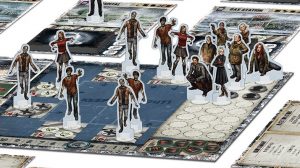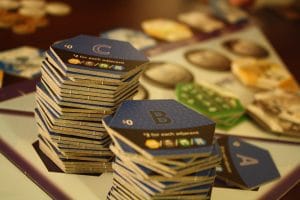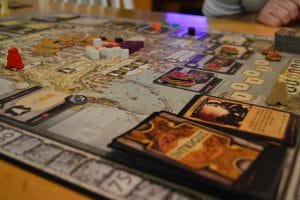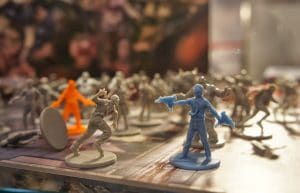I have approximately 43 Apple devices in my home, yet I also have a collection of modern board games as well. How are board games thriving in a digital World?
To say we’re in a board game renaissance would be an understatement. The board game industry has seen double digit growth for years now and I’d bet you a nickel that you have a friend who regularly hosts game nights.
Are we living in a crazy upside pocket dimension full of intelligent chimps and technomancer wizards, or is there really something interesting going on with the popularity of board gaming?
In order to answer that, we’ll need a brief history lesson. I’ll try not to make it boring.
 Germany is integral to the hobby of board games. In the time after World War II, Germany understandably didn’t encourage military toys for their kids, so they began to create games that were based instead on economics, trading, and other ways of engaging with each other. (While in the U.S., they were flexing their muscles in creating military games. Think of Risk, Axis and Allies, and the military miniatures games that were the early precursors to D&D.)
Germany is integral to the hobby of board games. In the time after World War II, Germany understandably didn’t encourage military toys for their kids, so they began to create games that were based instead on economics, trading, and other ways of engaging with each other. (While in the U.S., they were flexing their muscles in creating military games. Think of Risk, Axis and Allies, and the military miniatures games that were the early precursors to D&D.)
An enthusiastic industry built around these German games, such as the The Spiel Des Jahres (Game of the Year) award, where the media voted on which game families should buy for Christmas. German game designers focused hard on games for families to enjoy, and this led to a renaissance of creativity in 80s and 90s board game design in Germany, then throughout Europe. Meanwhile, North America was stagnant, creating more of the same — Scrabble, Clue, Monopoly, and those sorts of things.
As Atari, Apple, and Nintendo were making screens more engaging in America, German “Eurogames” (as they came to be called) were getting really elegant and sophisticated. Besides being extremely face-to-face social, they were becoming less luck based (roll of the dice) and more odds-based.
 These Eurogames weren’t necessarily known for simple rules, but they certainly were streamlined, well-designed, and balanced. Additionally, there was much less direct player competition, which was unlike the more combative, longer, luck-dependent games that are in the “Ameritrash” vein (like Risk or Axis & Allies).
These Eurogames weren’t necessarily known for simple rules, but they certainly were streamlined, well-designed, and balanced. Additionally, there was much less direct player competition, which was unlike the more combative, longer, luck-dependent games that are in the “Ameritrash” vein (like Risk or Axis & Allies).
Think of Monopoly: you play until everyone but one person is eliminated. That’s not very fun for a social activity.
But then the German game Settlers of Catan became the breakout game in America. For whatever reason, it was the magic missile that launched people into realizing that there were games out there that were not these sort of standard, destroy-everyone, player-elimination games like Sorry and Trouble that they had been used to.
Since Catan, board games have even gotten more sophisticated. The rules and game play has become even more accessible. New styles of games in the Eurogame mold have opened up co-operative gaming, so you can be working with everyone against the game. Only games like Pandemic have given the co-op an engaging Ameritrash theme to further increase popularity.
People often fondly remember their childhood favorites — Life, Scrabble, Connect Four, Sorry — but then realize they can graduate to newer, better games.
Still, how are they thriving in the digital age?
 In an era when smart phones, social media, and videogames dominate social interaction, board games provide a welcome cross-current.
In an era when smart phones, social media, and videogames dominate social interaction, board games provide a welcome cross-current.
Humans are physical beings and we like touch and we like tangibility, especially when engaging in shared activities. In cell phones and with video gaming, companies are trying to replicate that by creating screens that vibrate when you touch them to try to give the person some sort of tactile feedback, but in a tabletop world you have that feedback right away.
Handing someone cards, rolling dice, and moving pieces on a board – all while face-to-face – bring a board game to life in a way that doesn’t happen if it’s just on the screen.
But that doesn’t mean that screens themselves haven’t added to the innovation of board gaming! Games like Ticket to Ride and other tabletop games have app-based versions of their games that suit excellently to tablets. These are allowing people to try out the games at a much lower price point (around $5) than to buy the game in cardboard, which might be $50. These companies that are putting out app versions of their game are actually seeing an uptick in their tabletop game sales.
 Additionally, the internet has opened up tons of tools and means where board gamers can connect and strategize, most notably the gigantic barbarian horde that is Board Game Geek, the YouTube reviews of the Dice Tower, and the teaching tool of Watch it Played.
Additionally, the internet has opened up tons of tools and means where board gamers can connect and strategize, most notably the gigantic barbarian horde that is Board Game Geek, the YouTube reviews of the Dice Tower, and the teaching tool of Watch it Played.
Finally, America has had cult hits of its own. Board game Kickstarters like Zombiecide have made millions. While Cards for Humanity–a card where where you essentially participate with your friends in being vile and awful–is understandably a huge seller with the casual American gamer.
So what’s stopping you from jumping into the board game craze? Sure, you could binge another season of NCIS, but wouldn’t you rather trade sheep for ore or stop deadly diseases with some friends around your kitchen table?

